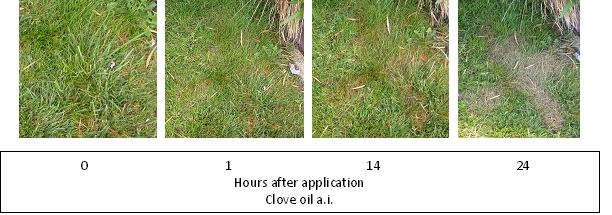With summer kicking in, I thought it would be a good time to revisit organic herbicides. That's because most of these contact postemergent herbicides work better at higher temperatures than cooler temperatures. So to get the best bang for your buck and the accompanying satisfaction of seeing weeds practically die in front of your eyes (see photos below), summertime is optimal for using these herbicides.
Examples of organically labeled herbicides are listed below. There were a lot more a few years ago and some may still be registered such as GreenMatch and Matran but I cannot find them on the current product lists of the company that registered them.
Work by Tom Lanini and others has also shown that higher volumes applications at are better e.g. 75 GPA works better than 35 GPA. However, this is a bit deceiving because the rates for these herbicides are usually provided as percentages or ratios. If the recommended rate is 25% formulated product at 35 GPA, you would be applying 8.75 gal product/A and at 75 GPA you would be using 18.75 gal product/A. Using a surfactant also improves activity and there are a number of organic surfactants available.
|
Name |
a.i. |
Signal Word |
|
Vinagreen |
Acetic acid |
Danger |
|
Nature's Guide 20% Vinegar Weed Control |
Acetic Acid |
Danger |
|
Avenger AG |
Limonene |
Caution |
|
Weed Zap |
Cinnamon and Clove Oils |
Caution |
|
Burnout II |
Clove Oil and Citric Acid |
Danger |
|
Axxe* |
Ammonium nonanoate |
Warning |
*Can only be used for maintenance weed control (ditches, roadways, etc.) and non-food crops. See OMRI certification.
Disclaimer: Mention of a pesticide or other product does not constitute an endorsement or a recommendation. Always check to see if the product is labeled and registered for your use before applying.
